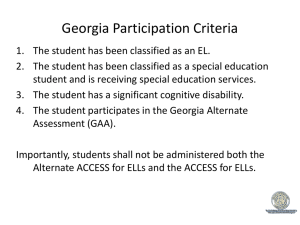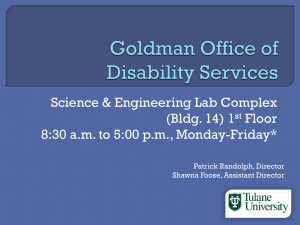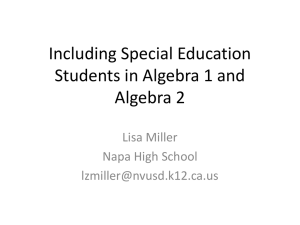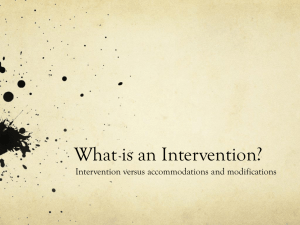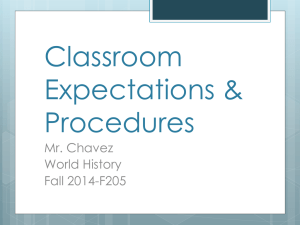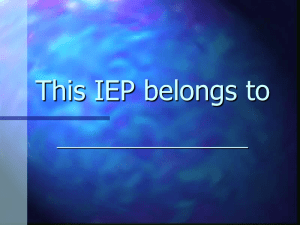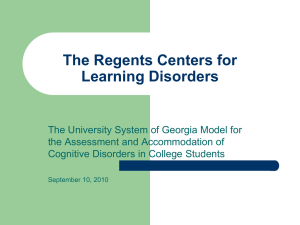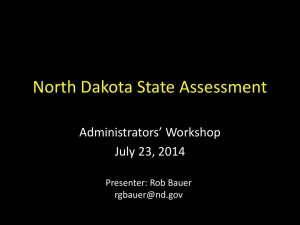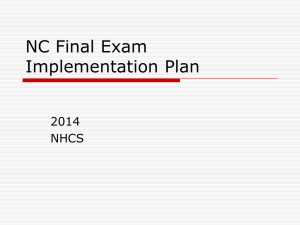Parent-to-Parent-Conference-Sep-12-20141
advertisement
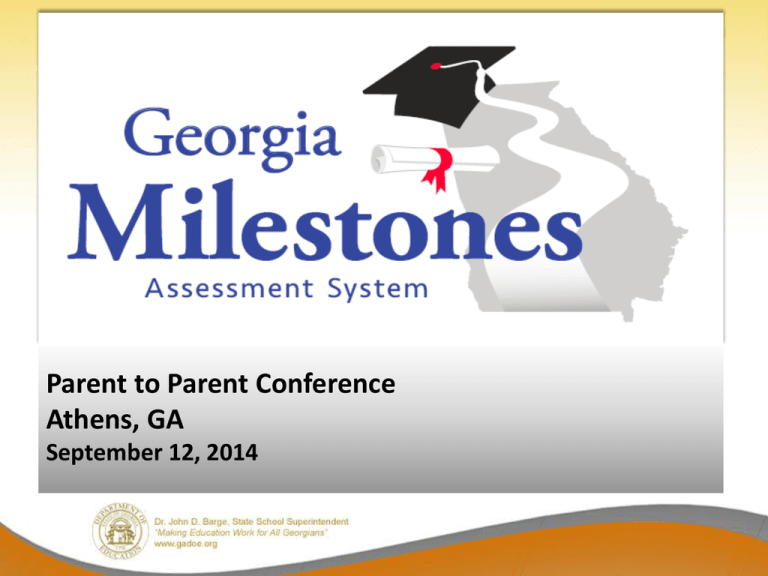
Parent to Parent Conference Athens, GA September 12, 2014 Georgia Milestones • Grades 3 – 8 – End of Grade (EOG) in language arts, mathematics, science, social studies • High School – End of Course (EOC) in 9th Grade Literature & Composition, American Literature & Composition, Coordinate Algebra, Analytic Geometry, Physical Science, Biology, US History, and Economics Georgia Milestones Comprehensive – single program, not series of tests (e.g., CRCT; EOCT; WA); formative assessment tools to complement summative Coherent – consistent expectations and sufficient challenge to position Georgia students to compete with peers nationally and internationally – consistent signal about student preparedness for the next level, be it the next grade, course, or college/career – consistent signal about student achievement both within system (across grades and courses) and with external measures (NAEP; PSAT; SAT; ACT) Consolidated – combine reading, language arts, and writing into a single measure to align to the standards The Need for a Comprehensive and Coherent System, Gr. 3-12 Achievement of Georgia Students in Reading (Elementary) - 2013 • NAEP – Grade 4: 34% at/above proficient • CRCT – Grade 4: 93% met/exceeded Achievement of Georgia Students in Mathematics (Elementary) - 2013 • NAEP – Grade 4: 39% at/above proficient • CRCT – Grade 4: 84% met/exceeded Achievement of Georgia Students in Mathematics (Middle/High) - 2013 • NAEP – Grade 8: 29% at/above proficient • CRCT – Grade 8: 83% met/exceeded • Coordinate Algebra EOCT: 37% met/exceeded • SAT – Class of 2013: 42% college ready benchmark* • ACT – Class of 2013: 38% college ready benchmark** Georgia Milestones General Test Parameters • ELA will consist of 3 sections, the last of which will focus primarily on writing • Mathematics will consist of 2 sections • Science will consist of 2 sections • Social Studies will consist of 2 sections Each section will be approximately 70 minutes. Georgia Milestones: Unique Features Features include: – inclusion of constructed-response items in ELA and mathematics, in addition to selected-response items – inclusion of a writing component (in response to text) at every grade level and course within the ELA assessment; – inclusion of norm-referenced items in every grade and content area to complement the criterion-referenced information and to provide a national comparison; and – transition to online administration over time, with online administration considered the primary mode of administration and paper-pencil back-up until transition is completed. Paper forms will also always remain available for students whose disability precludes them from interacting with a computer successfully. Addition of technology-enhanced items beginning in 2016-2017. Georgia Milestones: Unique Features Item Types • Selected-Response [aka, multiple-choice] – all content areas – evidence-based selected response in ELA • Constructed-Response – ELA and mathematics • Extended-Response – ELA and mathematics • Technology Enhanced – to begin in 2016-2017 • Constructed response is a general term for assessment items that require the student to generate a response as opposed to selecting a response. • Extended-response items require more elaborate answers and explanations of reasoning. They allow for multiple correct answers and/or varying methods of arriving at the correct answer. Writing prompts and performance tasks are examples of extendedresponse items. Online Tools Available for All Students • Blocking Tool These tools are available to all students who test online and are therefore NOT considered • Eraser accommodations. • Highlighter • Magnifying Glass • Mark for Review • Online Calculator – if allowable • Option Eliminator • Scratch Pad • Test Pause 8 Key Findings From Pilots of Formative Open-Ended Items • Overall performance shortfalls – Students were not familiar with these types of items • Many responded ‘dnk’ – as in ‘do not know’ – Students did not show their work, detail their thoughts, rationales, cite evidence to support their answer or claim • Tendency was to cite answer only – as if a multiple-choice item – Students did not read carefully and answer all parts of the question/item New Opportunities and Challenges • All students will experience new ways to show what they know. – The key to performance on the assessment is performance during instruction. • Classroom instruction and response requirements – should be of the same rigor and expectation as those experienced on the end of grade/course assessments. 10 English Language Arts • How can parents support students? – Read with your child • Ask questions – – – – – What was the text about? What is the main idea? How do you know? Show me in the text… Tell me 3 things that support your idea. • Read several articles about a subject or idea – How are the articles similar? – What points are different? • Evaluate what you read • Compare and contrast different texts and ideas. 11 English Language Arts • Practice writing – Strategies for practice: • Put the main idea on a card • Record facts, details from sources • Write a concluding statement to summarize. – Read the standards and become familiar with the grade level expectations 12 English Language Arts • Make reading and writing fun and purposeful at home. • Read about things that interest your child – Compare and contrast different sources • Song lyrics, articles about famous people, events • Recipes • Write a journal or blog – Make lists 13 Mathematics • Real world problem solving – Turn real life situations into word problems and determining the important information needed to solve the problem. • E.g., If we put new carpet in your bedroom, how many square feet will we need? • Based on the price of these samples, how much will that cost? • E.g. If the tires costing $95 each should last 30,000 miles and those costing $145 should last 60,000 miles, which one is a better value? • Students must be able to describe how they got the answer. – Communicate how they did their work 14 Mathematics • Strategies for mathematics--Communication – Model think alouds and have student do think aloud in return – Model writing the steps or explanation for solving a problem and have the child write it as they work through it. 15 Practice Using Technology • Practice writing using paper/pencil and via computer – Keyboard skills – Basic Word-processing skills. – Use technology often. • Word processing • Online Calculator – Practice during instruction • • • • • Blocking Tool Eraser Highlighter Magnifying Glass Mark for Review 16 Standards Based IEPs • IEP goals should tie to a standard, but not restate the standard. – They are the “value-added” that students with IEP’s require through specialized instruction. – IEP goals are in addition to the state’s content standards, not in place of – Mastery of IEP goals should be embedded within grade level instruction, not offered in isolation. 17 Standards-Based IEPs • Education data should be reviewed by content area for the individual student • Should include but not be limited to: – – – – Eligibility information Progress on IEP goals and objects Descriptions of supports needed to make progress Formative and summative assessment from the classroom – Results from previous state-mandated test administration 18 Standards-Based IEPs • In light of the responses now needed to demonstrate what students know • IEP teams may need to meet to discuss – Is the student making progress with the instruction given to all students? – Does the student need specialized instruction – Should assistive technology and accommodations for instruction be considered? – Do students need specific goals to develop skills needed to achieve the state standards? 19 Test Administration Accommodations 20 Test Administration Accommodations • Accommodations provide access for demonstration of achievement – Allow participation – Do not guarantee proficiency • and therefore should not be selected solely as mean to help ensure proficiency • Must be required by the student in order to participate in the assessment • Must be provided during routine instruction and assessment in the classroom (both before and after the state tests are administered) Key Considerations • For all students we should consider – – the student’s need for the accommodation – the student’s experience with the accommodation – whether the accommodation is of benefit to the student – the student’s feelings and beliefs about the accommodation Important Points to Remember • Allowable accommodations always grow out of the content and skills measured by the assessment and the purpose of the assessment • Teams and committees should consider the purpose and content of the assessment as well as the individual student’s need and circumstance when selecting accommodations • Inappropriate use of accommodations can (and does) negatively impact student achievement Types of Accommodations Standard Accommodations: those accommodations that provide access to the assessment without altering the construct measured by the assessment. Conditional Accommodations: more expansive accommodations that provide access for students with more severe disabilities who would not be able to access the assessment without such assistance. Conditional accommodations should be used sparingly. • The vast majority of students requiring accommodations should be able to successfully demonstrate their achievement with standard accommodations. 24 Examples of Standard Accommodations Students with Disabilities (SWDs) Setting Presentation Special education classroom Large Print/Large Font) Special or adapted lighting Sign the directions Small group Sign test questions Preferential seating Oral reading of test questions in English Sound field adaptations Individual administration Test administered by certified educator familiar to student Technology applications, such as Braille, word processor, or other communications device with all grammar and spell check devices disabled Student marks answers in test booklet Student points to answers Verbal response in English only Presentation Frequent monitored breaks Optimal time of day for testing Extended time Flexibility in the order of administration for content areas Explain or paraphrase the directions Scribe for clarity (in English only) Adaptive furniture (e.g. slant board) Braille Individual or study carrel Response Braille writer Color overlays, templates, or place markers Abacus Low vision aids (e.g. CCTV, magnifying equipment) Adapted writing tools (e.g. pencil grips, large diameter pencil) Repetition of directions (in English only) Adapted/ lined paper Audio amplification devices or noise buffer/listening devices 25 Conditional Accommodations • More expansive accommodations that provide access for students with more severe disabilities or more limited English proficiency who would not be able to access the assessment to demonstrate their achievement without such support – must be used sparingly, per State Board Rule – must be considered when interpreting scores Conditional Accommodations • There are three accommodations that are considered conditional: – Signing reading passages (Students w/Disabilities, SWD, only) – Reading of reading passages (SWD or English Learner, EL) – Use of a basic function calculator (SWD only) in grades 3 – 5* *Specified calculators allowed for all students in grades 6-12 in mathematics and the Physical Science and Economics EOCs. Why must we attend to the guidance for conditional accommodations? 1. These accommodations were never intended to be available for all students. 2. The guidance is designed to protect the accommodations for students who truly require them. Why must we attend to the guidance for conditional accommodations? 3. Anytime an accommodation is considered it is important to reflect what the test is designed to measure. – The goal is meaningful (i.e., valid) measurement of student achievement 4. It is important to consider the long term effects of inappropriate accommodation use. – Accommodations should foster independence, not dependence Conditional Accommodations • Guidance on the appropriate use of conditional accommodations is provided in the Student Assessment Handbook • Only students meeting the guidance criteria are eligible for conditional accommodations • The educational plans for students qualifying for conditional accommodations must include specific goals that address the deficits which necessitate the accommodation New Accommodations Chart • IEP, IAP, and EL-TPC teams should review table to determine what accommodations are available online versus paper. • Conditional accommodations are indicated by “C” in accommodations table. Note that all Oral Reading (“read-aloud”) accommodations will be delivered through online testing, with standardized language, and through the use of headphones. 31 New Accommodations Chart • IEP, IAP, and EL-TPC teams must note the differences between legacy programs and the Georgia Milestones Assessment System. • The logistics of providing accommodations during assessments must be planned well in advance of the opening of a district’s local testing window. 32 New Georgia Milestones Webpage Has Launched! http://www.gadoe.org/Curriculum-Instruction-andAssessment/Assessment/Pages/Georgia-Milestones-Assessment-System.aspx 33 Reporting for Year 1 (2014-2015) • Required technical work will result in scores being reported in Fall 2015 – Inclusion of a full year of student data in the setting of achievement standards – Input of Georgia educators – Standard Setting • Policy aspects for 2014-2015 – State Board approved GaDOE’s request for a waiver of the testing requirements relative to Grade 3, 5, 8 promotion – State Board approved GaDOE’s request for a waiver of the requirement that end of course assessments serve as the final exam and comprise 20% of the final course grade (through Summer 2015) • Accountability aspects for 2014-2015 – Students must participate (CCRPI Participation Rate) in the appropriate Georgia Milestones assessment – Georgia Milestones participation and performance will be reported in the 2015 CCRPI Report 34 Transition to Georgia Milestones: Resources Available NOW • Content standards – frameworks, formative lessons, PARCC evidence statements • Sample items – formative items/benchmarks via Georgia OAS→GOFAR; – released items via PARCC, SBAC, other states (KY, NY), NAEP – parent’s guide to Georgia’s new assessment developed by the National PTA [http://www.pta.org/advocacy/content.cfm?ItemNumber=3816 ] • • • • • • CRCT Readiness Indicators Lexiles (as one indicator of text complexity) Technology Specifications Calculator Guidelines Eliciting Evidence of Student Learning Modules Accommodations Guidelines Focus on teaching and learning – eliciting evidence of student learning during instruction and adjusting as needed. Transition to Georgia Milestones: Resources Available Soon • Sample items specific to Georgia Milestones • Ancillary support resources, such as – Assessment Guides – Student Study Guides – Informational videos [parents & public /educators] – Experience Online Testing Practice Center (to aid students in gaining familiarity for CTB’s online test administration system)
